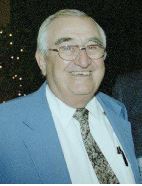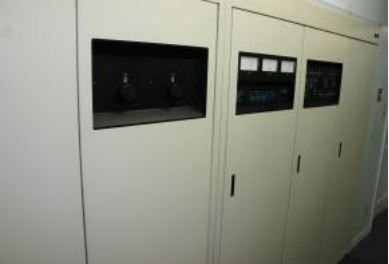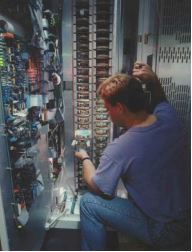How and Why Quincy, IL Became the Digital Capitol of the World Part 3 – DX Changes the World

[January 2010] We have been tracing some of the history that involved Quincy, Illinois as the broadcast industry moved from analog to digital transmitters. Here, in Part 3, Tom Yingst brings us fully into the digital age with the DX series of transmitters – and more.
As 1988 began, I turned down a teaching position at Penn State University to accept a job at Harris. It was supposed to be a one-year job, but over the next 8½ years I had quite a ride as Harris made the leap to become a premier supplier of solid-state transmitters to the broadcast industry.
All Solid-State Comes of Age
Until this time, the only completely solid-state transmitter from Quincy had been the MW-1. Parts costs at the higher powers kept tubes running the MW-5, MW-10, and MW-50. But technology had jumped in the 80’s, and costs started to drop.
The start for digital radio in Quincy really got under way in 1987, when the DX-10 – a 10 kW medium wave all solid-state transmitter – was shown at NAB. However, it was not yet price competitive at the time, and the program was placed on the “back burner.”
Hilmer Swanson actually had been working on the DX concepts for many years prior to 1987, but other programs took priority, and it was thought that a market did not exist yet for this advanced concept. The majority of the production at the time was the Gates or equivalent Harris MW series, using Swanson’s approach using Pulse Width Modulation (PWM) technology at a sampling rate of 70 kHz.
Although Harris Broadcast had just gone through a major downsizing and restructuring program due to market conditions, the stage was set for recovery. Under the leadership of Guy Numann from the Harris Corporate Headquarters, support was provided for the major improvement programs including new product developments and introductions, concentration on international sales (mostly DX transmitters and associated items) and major factory improvements.
During the same general time period (starting about 1982), Nautel was also supplying all solid-state medium wave transmitters to the broadcast market in the US, but production was limited to 50 kW maximum.
The DX Series Flowers
It was in 1988 that the DX Transmitter concept really jelled. Concentrated engineering, marketing, and production plans were initiated – including a major cost reduction program for the DX-10 – where the concepts were immediately applied for power levels up to 50 kW (and higher for the international market).

DX-50, Serial #1, at KFBK, Sacramento
We quickly saw that the DX concept not only was technically a worldwide leader, but it also could become price competitive with the older technologies in the world market. But the stage was being set once again for the Quincy digital future, with an emphasis on high power.
Emphasis was immediately placed on the development of a 100 kW basic power block for DX, each of which used thousands of field effect transistors (FETs). The blocks could be produced in volume in the factory under standard conditions, benefitting from the cost reduction programs.
Further development of the amplifier blocks reduced the number required for higher power levels. This included improvement of the power FET devices, allowing higher voltage and thus higher power as the power block size was increased. The power block was immediately re-directed toward 150 to 200 kW; when combined they eventually reached power levels up to 2000 kW.
Before long, the improved performance and reduced costs for high power proved the DX series was now clearly competitive with existing designs in the worldwide market.
Developing the Market
In the late 80’s and early 90’s the US market for radio transmitters was fairly low. Thus Quincy was redirected to rebuilding the international penetration with emphasis on high power (above 50 kW, and up to 2000 kW for MW). Although MW power levels in the US are limited to 50 kW, and internationally higher powers are common. Manufacturers must be dominant in high power to be part of this overall market.
The DX-300 is one example of how the DX transmitters were introduced to the international market. We invited transmitter users to come to Quincy to evaluate and see if the transmitters met their requirements. This was a very successful program and was later applied to even higher power DX transmitters.
The basic plug-in amplifier at 1500 Watts uses about 8 FETs, at 200 kW there are 225 blocks or eight times 225 – or 1800 – FETs. A DX-1000 uses about 9000 FETs at full power, yet the measured power block MTTF (Mean Time To Failure) is in the order of 100,000 hours using soft failure concepts. Compared to 3,000 hours for previous designs, this is a major magnitude of improvement.

By adding more groups of modules,
Megawatt power levels could be achieved.
Looking at the number of amplifiers required, the reader can see that production must be ready for high volume setups. In this case, the upgraded production at Harris Broadcast in Quincy met the requirements and was a major reason for the overall DX series success, as well as the extraordinary performance and reliability coming from reliable, cost-effective transmitters.
A DX-1000 uses about five blocks of 1800 FETs – solid-state amplifiers that are turned on in the proper sequence using the digitized audio rate to achieve 200 kW carrier power with high positive modulation voltage. Then the 200 kW blocks are combines to reach 1000 kW.
This very high volume base for nominal 1500 Watt amplifiers was the key to the development of extremely efficient manufacturing base and again setting the stage for the digital future in Quincy and is the very reason why this very competitive Quincy factory had become a major world source for digital MW transmitters. It also should be noted that the FETs used were already used for switching power supplies – and since Quincy used these FETs in the tens of thousands each year, the price was reduced while quality was increased by working with the suppliers.
Customer Approval
The customers accepted the DX-300 after a heat run at tone modulation on the order of 120% positive, 99% negative for a 12-hour heat run. In contrast to tube transmitters which works the tubes harder as modulation and RF power increases, the DX concept simply turns on more solid state amplifiers when more carrier power and more modulation signal is used.
At the Broadcast Show in Tunisia for the Arab States Broadcast Union in 1989 we announced the DX concept would go to multi-megawatts – and maintain the outstanding characteristics reported and recognized at lower powers. This clearly set the stage for the future at all power levels from 10 to 2000 kW for the international market, as well as the 10 to 50 kW market in the US. However, it also created lots of doubt among competitors – and some people within Harris – as to whether this was the “right” market for Harris to pursue.
The approach led to 200 kW, 400 kW, 600 kW, 1000 kW, and eventually 2000 kW transmitters for the world market. Calculations by Geoff Mendenhall and a team from VOA proved the DX concept could be a transmitter of very high reliability at all power levels, and the actual measured results proved this to be the case as data was collected. Evaluations facilities are now available in Quincy for all ranges of powers for MW/LW.
All of the customers were impressed by the capabilities and facilities in this small Midwest town and always made comments. Quincy was being recognized as a worldwide high technology transmitter supplier, in competition with well-established electronic suppliers anywhere.
Growth Despite Imitation
Part of this international marketing thrust was really initiated, unknowingly by myself in the early to mid-80’s, with the transmitter and tube organizations in China. As a direct result of these contacts, we were later advised that a major competitor was deeply involved in the proposed major upgrade of China’s huge Broadcast Transmission System (reported to exceed 40 megawatts by the former Chief Engineer of the Beijing Transmitter Factory).
This resulted in visits to China to make presentations on the Harris DX approach for their planned upgrades, in competition with the competitors’ tube approach. The Quincy presentations demonstrated to the Chinese Broadcasters and Administration approaches that were not only price competitive but had world leading solid-state technology.
This resulted in an immediate order for ten 600 kW DX transmitters to be delivered in approximately one year and in over 20 megawatts of DX installed power in future years. Interestingly, although the Chinese manufacturers were allowed to clone the DX concepts, the continued cost improvements, outstanding performance, and reliability from the Quincy products kept the Chinese from competing against Harris (a lesson learned from the VHF program with RCA years before).
Television and FM Advances
During this period in late 80’s and early 90’s, the Harris Broadcast Division established a leadership position in all solid-state VHF transmitters up to 60 kW and captured 70% of the US market. UHF also made major strides at the time with the new MSDC Klystrons transmitter, all with excellent operation results and reliability.
Furthermore, a new FM exciter was introduced along with solid-state amplifier units up to 1 kW, able to use a single tube output for up to 25 kW. The engineer working on the development was placed outside the normal engineering budget responsibilities to finish the project. This is another case where technology must move forward and it was a good use of an engineer’s idea.
Starting about 1993, Geoff Mendenhall became a world-renowned expert in FM Exciter design for Harris. Before that he had been working on FM systems for BE. At the time Quincy did not fully recognize that the stage was being set for the new digital systems of the future like IBOC and DRM which became key digital production items in future years.
Solid Corporate Results
Altogether, these new programs and fantastic support people powered Harris Broadcast Division from the lowest performing division to number 2 out of 21 Harris Corporate Divisions in three short years. It is still recognized as a world leader in the MW/LW markets. The DX series was a major contributor to this turn-around, supporting the FM and TV programs.
No great idea can move forward without a first class marketing thrust and a competitive production center under a future-oriented corporation, as was the case in Quincy. Quincy factories became very efficient for the manufacture of all solid-state digital transmitters throughout the 1988 to 1995 time period. During that time, they led the world market in the very efficient, cost effective transmitters for the medium wave (MW) and LW market as well as FM and TV, and thus held off the obvious competition.
Through the outstanding design concepts of Hilmer Swanson, and equally outstanding production and engineering support centers at the Harris Quincy factory (old Gates Radio), Harris Broadcast moved from about 10% of the world MW/LW business to greater than 30% market share. During that same time Harris developed an installed base over 2.5 times their nearest competitor for the all solid-state digital MW/LW transmitters, again supporting Quincy being Digital Radio Center of the World concept.
By 1995, approximately 600 DX transmitters were installed around the world. Quincy factories were very busy during this time period. In fact during the early 90’s Swanson was honored by the NAB for his technical contributions to Medium Wave transmitter technology. This award was followed later by one from the NAB to Geoff Mendenhall (1999) at Harris Broadcast for his FM and other contributions to the Broadcast Industry.
Collected data supported the extraordinary measured reliability and outstanding performance of the DX series. Such high reliability led to the control of high power 600 to 1000 kW MW transmitters from phone lines remotely, allowing greatly reduced maintenance costs for owners like VOA and RFE.
Competition for the Quincy MW/LW products started to build in full force in the mid-90s even as the market share stabilized (or dropped slightly), but Quincy remained in a very competitive mode. Furthermore, IBOC – mostly FM HD Radio – was getting started in the USA and supported the Quincy product line well into the 2000’s, as well as products from other US transmitter suppliers.
Adding Digital Audio
Moving on past 1996, the digital transmitter design concepts led to wide bandwidth and high switching frequencies to digitize the audio, ultra stable phase and amplitude linearity. All this set the stage for the conversion to Quadrature signals required for the new future concepts for the IBOC & DRM. DX was clearly ready for the new digital world of the future again filling a void in manufacturing as the TV & FM digital world developed and became more saturated.
Of course, any great concept also must be produced at a competitive price and must be ready to handle the obvious competition which develops when any company is successful in a given world market. As digital radio blossomed, this would prove to be a challenge for Quincy manufacturers. We will bring our story to a close with the race to install HD Radio.
– – –
Now retired, Tom Yingst was right in the middle of the broadcast industry as it moved from analog to transistor to microprocessor. Contact Tom at TEY1926@aol.com
